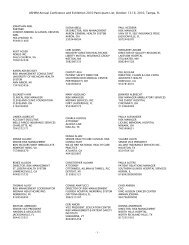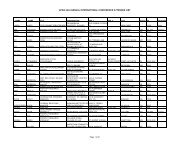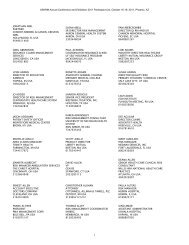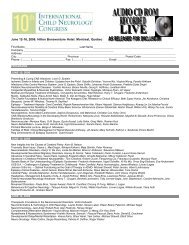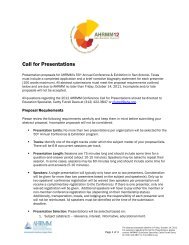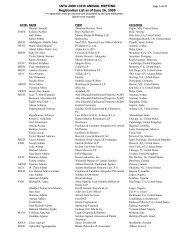learn. connec . advance. - SoftConference.com
learn. connec . advance. - SoftConference.com
learn. connec . advance. - SoftConference.com
Create successful ePaper yourself
Turn your PDF publications into a flip-book with our unique Google optimized e-Paper software.
detailed schedule<br />
Tuesday, July 22 Tuesday, July 22<br />
1:45 pm – 3:00 pm<br />
Learning Lab 3<br />
3.1 Robots and the Supply Chain<br />
Distribution B M<br />
Room: 209<br />
Providence Hospital in Washington, DC is using an autonomous<br />
mobile robotic system to streamline its supply chain and free up staff<br />
for patient care. The system removes a major bottleneck in the delivery<br />
of care by locating and transporting goods and supplies directly to the<br />
point of care. The robots are also used to deliver equipment,<br />
medications, lab specimens, and pick up par stock and late food trays.<br />
The net result is improved clinical productivity and patient care,<br />
significant cost savings, and elevated employee satisfaction. Learn<br />
about how the hospital is currently testing the robots to identify<br />
equipment as it <strong>com</strong>es through the door, track equipment, identify<br />
equipment that needs to be serviced or replaced, and enable nurses to<br />
look at inventory and request necessary equipment.<br />
Peter Seiff<br />
Vice President, Customer Solutions, Aethon<br />
Pittsburgh, PA<br />
Mark Todd<br />
Director of Materials Management, Providence Hospital<br />
Washington, DC<br />
3.2 Value Analysis You Can Count On<br />
Finance I<br />
Room: 213<br />
Most hospitals agree – value analysis can be an effective tool for<br />
achieving supply chain savings without sacrificing clinical performance.<br />
However, considerable debate remains over how to structure a value<br />
analysis program and whether the effort required is <strong>com</strong>mensurate with<br />
the results. This presentation will show not only how to develop a<br />
value analysis program that works, but also how to determine if it is<br />
truly achieving the results you intended. By assembling the right team<br />
members, establishing clear, actionable clinical and financial<br />
objectives, and ensuring access to accurate data for reporting and<br />
analysis, your value analysis team can effectively model “what if”<br />
scenarios to calculate the potential benefits BEFORE taking<br />
action. Once the initiatives are underway, you can monitor whether<br />
the necessary changes are being implemented as intended and<br />
measure and report on the actual results. Attend this session, and put<br />
these proven principles to work to optimize your contract <strong>com</strong>pliance,<br />
standardization, and new productclinical trials and analysis for savings<br />
you can count on.<br />
Christine Creedon<br />
Director, Customer Value, GHX<br />
Westminster, CO<br />
3.3 Maximizing Capital Investments in Equipment<br />
Technology Solutions A<br />
Room: 207<br />
High-tech medical equipment investment decisions are increasingly<br />
being driven by a variety of factors including financial and clinical<br />
return on investment (ROI). The Veterans Health Administration (VHA)<br />
recently developed and deployed a Portfolio Management System for<br />
Capital Equipment that enabled them to ac<strong>com</strong>plish the following:<br />
forecast capital equipment needs and develop investment strategies<br />
across a multi-year planning horizon; <strong>com</strong>bine quantitative scoring<br />
and prioritization with qualitative clinical judgment; utilize multiple<br />
variables in calculating return on investment; align investment<br />
decisions with strategic business objectives such as quality, access,<br />
satisfaction, and value; standardize business processes and hardwire<br />
stakeholder involvement in investment decision making; align<br />
investment decisions with the budget cycle; and improved decisionmaking,<br />
acquisition, and installation cycle times.<br />
Mark Fontaine-Westhart<br />
Chief, Logistics Officer, Department of Veterans Affairs<br />
Albany, NY<br />
Victor Heinrich, CMRP, FAHRMM<br />
Victor E. Heinrich & Associates Inc.<br />
Ellicott City, MD<br />
3.4 RFID Primer for Materials Managers<br />
Technology Solutions I<br />
Room: 206<br />
This presentation will give the audience a basic understanding of RFID<br />
technology including its limitations, capabilities, and how it can be<br />
applied in Materials Management. Those who attend will obtain a<br />
deeper understanding of the technology and how it works through<br />
examples of where it can be applied to receive a return on investment<br />
for the software and hardware that is used in the systems.<br />
Al Cook, CMRP, FAHRMM<br />
Director of Healthcare Product Development, Integrated Business<br />
Systems and Services (IBSS)<br />
Orangeburg, SC<br />
Jean Sargent, CMRP, FAHRMM<br />
Director, Materials Management, University of Kentucky Medical Center<br />
Lexington, KY<br />
34 35



